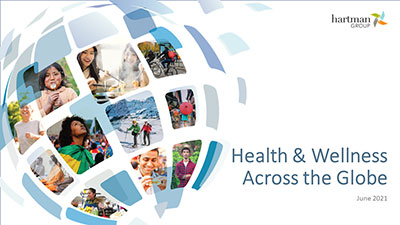
Prior to the global spread of COVID-19, health & wellness was already a top priority for many consumers. While the pandemic has certainly been a key catalyst in driving consumer demand for health & wellness products, it is not the only force. Factors like an aging population and chronic conditions, and beliefs about the immediacy of environmental concerns combine with cultural variations to create a patchwork of attitudes and behaviors related to sustainability around the world.
Despite cultural differences around the world, consumers display many similarities in approaches to and attitudes toward health & wellness, particularly during a global event such as the COVID-19 pandemic, which has brought shared immediate priorities to the fore.
Here, we share highlights from The Hartman Group’s recent Health & Wellness Across the Globe report on consumers’ behaviors and attitudes toward health & wellness.
The global survey was conducted in six countries: USA, China, Brazil, Germany, India and Mexico.
I’m healthier than others
Comparing one’s own health to other citizens reveals that most are optimistic about their own status. This tendency to rate oneself higher than others is particularly prevalent in Mexico, Brazil and the USA. Chinese and Germans are the most likely to see themselves as close to average when comparing their health to that of others.
Health & wellness means “feeling good about myself”
Feeling good about oneself ranks among the most important aspects of health & wellness for consumers in the USA (51%), Brazil (77%), Germany (65%), India (48%) and Mexico (61%), but not in China (34%). In most of these countries, strong immunity ranks among the top three meanings of health & wellness, perhaps related to their deep cultural ties to food as medicine.
Immunity, balance and positive mood are also considered top elements of health & wellness in several countries.
“Areas of my life that need improvement” varies across the six countries
USA. Almost all USA consumers would like to improve their physical appearance, though just 13% consider this an urgent concern. While more than half report wanting to improve a wide range of aspects of their lives, a quarter or more say that being physically fit, not being overweight or feeling good about themselves are areas that need to improve urgently.
Brazil. Overall, the top aspirations held by Brazilians involve donating to the community and helping the environment, with at least 90% saying they would like to make improvements in these areas. In terms of urgent change, the top aspirations are stress management, financial stability and physical fitness. In fact, around half of those who report a need for improvement in these areas say the need is urgent.
China. Most Chinese consumers have wide-ranging health & wellness aspirations, with physical fitness, relaxation and balance the most urgent priorities.
Germany. Germans see an urgent need to get more physically fit, and many are also particularly concerned with avoiding illness and staying positive.
India. Avoiding illness rises to the top of health & wellness priorities for Indians, though more urgent concerns include physical fitness and mental well-being.
Mexico. Mexicans see room for improvements in many areas of their health & wellness, especially urgently needing to deal with stress and getting more physically fit.
Across most of the countries, anxiety/stress and aches and pains are the top conditions being treated or prevented
Consumers report preventing more conditions than they are treating, with Mexico, China and Brazil reporting especially high ratios of prevention to treatment. This is likely due to the relatively young populations in these countries, since many conditions increase in prevalence with age, while younger consumers are more likely to be focused on prevention.
Consumers use a range of modalities to manage their conditions. Generally, food and beverages tend to be used primarily to manage conditions with a direct link to diet, including weight, digestion, food allergies and others. Across all six countries, food and beverages are more commonly used as preventative measures than as treatment.
The Hartman Group identified three segments in each country based on their level of engagement with health & wellness: Engaged, Aspiring and Indifferent
Respectively, these segments constitute 13-18%, 56-63% and 24-28% of consumers in each country. The demographic makeup of each segment varies across countries, indicating differences in who participates in health & wellness in each geographical location. However, in most of the countries studied, the Engaged segment shows higher levels of employment, higher education and greater income levels.
About the Health & Wellness Across the Globe report
The Hartman Group’s Health & Wellness Across the Globe report provides in-depth analysis and robust insights backed by a range of data on some of the most important health & wellness issues of the day, including: engagement in health & wellness, conditions treating/preventing, optimism for the future, approaches to diet and meals, healthy eating at food service and perspectives on sustainability. Order your copy of the report here
some of the most important health & wellness issues of the day, including: engagement in health & wellness, conditions treating/preventing, optimism for the future, approaches to diet and meals, healthy eating at food service and perspectives on sustainability. Order your copy of the report here
